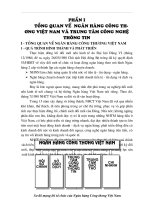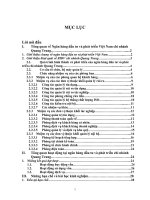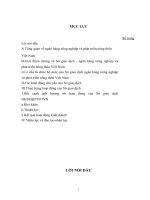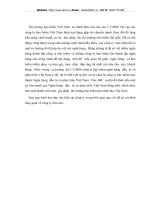TỔNG QUAN VỀ TÀU HÀNG VÀ XẾP DỠ HÀNG HÓA(PPT CARGO AND PACKAGING)
Bạn đang xem bản rút gọn của tài liệu. Xem và tải ngay bản đầy đủ của tài liệu tại đây (2.27 MB, 58 trang )
Cargo and Packaging
UNESCAP
Transport & Tourism Division
Chapter objectives
• On completion of this chapter,
you should be able to:
– Understand the transformation
from cargo to commodity
– Describe the packaging
requirement of the different types
of cargo.
– List the guidelines on the choice
of packaging.
– Know the principles of packing
cargo in container.
From commodity to cargo
•
When gas is moved onboard
ships, it is often liquefied by
low temperature. This is a
highly specialised form of
transport requiring not only
expensive, purpose built
carriers, but also special
terminals and handling
equipment.
•
The advantages of cooling
gases can be evidenced in
the simple arithmetic that
liquid gasses can be reduced
by about 600% of the liquid
form.
A Typical LNG Vessel
Liquid cargo carrying ships
• liquid cargoes e.g. crude
oil and its refined
products, vegetable oils,
wines, latex, various
chemicals and water are
carried loose in ships,
i.e. they are pumped
from tanks on shore
through pipelines to
tanks onboard the ship
and vice versa. This is
the practice for very
large crude carriers
(VLCC).
A Typical VLCC
Dry bulk cargo
•
The dry cargoes embrace raw
materials, semi-finished or
finished goods. They do not
require the same containment
as gases and liquids.
•
The number of dry cargo
types is almost endless. The
type of commodity, the level
of finishing, and the transport
method will determine the
need for packaging and
storage requirements.
Loading of dry bulk cargo at dedicated
bulk terminal
Cargo physical forms
The ways Dry cargo is shipped
Physical form Unit load
Dry cargoes
Liquid
cargoes
Break bulk
e.g. bagged rice e.g. machinery
parts in crates
in whole load
and boxes
e.g. whole load e.g. part loads
of oil in drums of wine in cases
Bulk cargo
e.g. loose grain
in holds
e.g. crude oil in
tank vessels
Cargo in its different forms
General Cargo
• General cargo can
consist of numerous
small parcels.
• It is usual to tally
such cargo onto and
off the vessel while
loading/discharging
Cargo handling operations at a
conventional cargo berth.
Containerised Cargo
•
•
•
•
Containerised cargo is not
man handled on and off the
ship, instead the container is
handled with fast and
sophisticated handing
equipment.
In developed countries where
labour is expensive significant
savings can be made
The cargo needs less
protective packaging.
The cargo can be stowed in
the container away from the
wharf, often by the shipper
himself.
A General Purpose Container
Containerised Cargo
•
Insulated to control temperature
some have no means of
refrigeration at all.
•
Some have mechanical
refrigerating equipment and/or
heating equipment built into one
end or the sides of the container.
•
Others rely on clip-on units
attached to the front of the
container, or systems at the
terminal and ship.
•
Some rely on cryogenic
refrigeration (temperature
control).
A refrigerated (reefer) container.
Power supply
• Typical sockets
connecting the ship’s
power source to the
refeer container.
Comparison of container types
Type
Typical Cargo
Insulated containers
Used for frozen or cool cargo
Half height units
Steel or other heavy items
Flat racks
Timber, vehicles and odd shapes
Open top containers
Over height items
Bulk boxes
Bulk cargo such as grain or fertilisers
Open sided
Ventilated cargo such as onions
Tank containers
Liquids and chemicals in bulk
Container seals
• Various makes upon
the market to choose
from.
How to stuff a container
• The movie opposite is
provided by the UK P&I
Club. (an organization that
investigates many cargo
damage claims in order to
establish whether their
members, usually the
shipowner, are at fault.)
• It shows what happens
to a container at sea and
how to reduce risk.
30 minute video
Before packing a container
•
Packing a container should
always be done on level
plane either on the ground, on
a railcar, or on a trailer.
•
Stowage should be planned
before packing is commenced.
•
The planned load should not
weight more than the payload
of the container which is
marked upon it.
Dry bulk cargo
•
Many bulk cargoes have
hazardous properties, or can
change their properties on
passage.
•
The ship can be easily
damaged by incorrect loading.
This ‘stress’ can have life
threatening results in rough
weather. Residues from
previous cargoes can also
effect latter cargoes.
•
It’s difficult to ascertain true
weights or quantities of
cargoes loaded/discharged.
Discharging bulk cargo using
“grab”
Coal
•
Coal is transported on all
types of bulk carriers from
handy size to VLCBs.
•
It can emit methane gas, is
self-heating and contains
sulphur which causes severe
corrosion when in contact with
the ship's steelwork.
•
In most ports the cargo is
loaded wet to reduce dust.
Much of this moisture settles
on passage and is pumped
out through the ship's hold
bilges which means that less
weight is discharged than is
loaded.
The loading arm at a coal
terminal which is awaiting the
berthing of a ship
Iron Ore
• This cargo is loaded very fast, 10,000
tonnes an hour.
• The loading and de-ballasting of the ship
must be meticulously planned to ensure
that the vessel is not overstressed.
• There is very little chance of damaging
the cargo but the ship can receive
extensive damage during the discharge
operation from the equipment used.
Grain
•
One of the most difficult and
dangerous cargoes to carry in
bulk are grain cargoes.
•
Most grains have an angle of
repose (slip angle) of about 20°
from the horizontal, which means
that if the ship rolls more than
20° the cargo will shift making
the ship prone to capsizing.
•
Foodstuff, are susceptible to
claims of contamination from a
previous cargo
•
Vermin can also be a problem.
Loading of grain using movable
loader fitted with “chute”
Liquid cargo
•
There is a high risk of
contamination when a
common pump is used for
several cargo tanks, if the
system is not properly drained
between different cargoes.
•
The vapours from one cargo
tanks can easily enter a
different tank in the system.
This may result in cargo
contamination or change the
flash point of the product.
Connecting shore loading arm to
the ship’s manifold onboard a
tanker.
Chemical tankers
•
Constructed with completely
independent cargo systems,
each
tank will have an
independent
pumping
and
venting system.
•
Cargo contamination in chemical
tankers are often caused by poor
cleaning of cargo tanks or pipe
lines.
Unfortunately
many
chemicals
are
extremely
sensitive to contamination, just a
few parts per million of a
previous cargo can contaminate
an entire shipment.
•
Cargo transfer hoses may also
contribute
to
cargo
contamination, therefore hoses Connecting shore loading arm to the
should be properly cleaned in ship’s manifold onboard a tanker.
between different cargoes.
Cargo Handling
• The techniques of cargo handling have, at
least in ocean transport, developed
considerably over the last decades. This is
particularly due to:
• Technological advances in ship design and
lifting equipment
• Rapid development and increase in the
tonnages of bulk cargo
• The impact of unitisation, and
• The new and modern techniques of
refrigeration, particularly with container
carriage.
Cargo preparations
•
In break bulk. Packaging has
at least three functions:
– To protect the goods;
– To keep a consignment
together;
– To prevent the goods from
damaging the environment.
Unstuffing bagged rice from a container.
Cargo loading and discharging
• Modern gantry
cranes usually
handle 35 moves an
hour.
The use of quay cranes in
modern container terminal help
in reducing vessel’s turn around
time.
Bulk cargo handling
•
Efforts to increase cargo
handling times have
concentrated mainly on the
transfer medium
•
This has led to the
development of a wide range
of mechanical equipment,
such as cranes, conveyors
etc., which has substantially
improved loading and
discharging rates, especially
for bulk cargoes.
The use of modern handling equipment
in bulk handling operations such as
mobile unloader connected to a conveyor
system shown here will facilitate the
smooth movement of cargo at the port
interface.
horizontal loading
• Horizontal loading of
cargo is done through
openings in the bow,
side or stern of a ship.
• These ships are
commonly referred to as
roll-on/roll-off (Ro/Ro)
ships as the cargo can
be accepted on wheeled
vehicles.
• Flexibility and fast port
turnarounds are key
features.
Discharging of a train coach
via the stern door of a Ro/Ro
ship.









